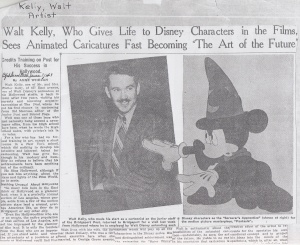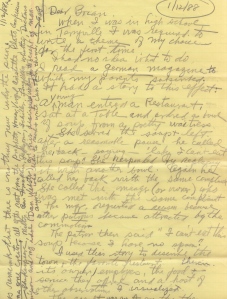I spent three days last week at the Festival of Cartoon Art hosted by the Billy Ireland Cartoon Library and Museum at the Ohio State University in Columbus. You can read more about the Festival and the grand opening of the Billy Ireland’s beautiful new building at Charles Hatfield’s blog and in Christian Hoffer’s article at The Outhouse. Tom Spurgeon also includes several links to photos from the Columbus festivities at The Comics Reporter.
I’ll write in more detail about my experiences at the Festival in my next couple of blog posts. As Charles notes in his report, the weekend was so filled with excellent presentations and inspiring talks with artists, scholars, and critics that it’s difficult to know where to begin. Rather than talk directly about the sessions, or about Jeff Smith and Paul Pope, or about the Hernandez Brothers, I’d like to consider a brief conversation I had with Charles about memory and nostalgia and geography.
How does a sense of place shape our understanding of both space and time? Looking out the window of my room on the fifteenth floor of the Hyatt Regency, I saw a network of grey concrete overpasses, redbrick factory buildings, a Wonder Bread sign in huge red letters. I was in Columbus to talk about Walt Kelly and his boyhood in Bridgeport, Connecticut—his family’s move from Philadelphia to the coast of Long Island Sound when he was only two years old; his father’s work at the Remington Arms Company during the city’s World War I boom years; Kelly’s love of bird watching. In the closing paragraphs of my essay I argued that Kelly is a New England regionalist, an artist in the tradition of other writers like Sarah Orne Jewett and Jack Kerouac (Kerry Soper, who presented an excellent paper on race, stereotype, and Pogo, gestures towards this argument in his book We Go Pogo when he discusses the connections between Kelly and Mark Twain. Kerry situates Kelly’s Okefenokee Swamp not in Georgia but in a landscape adjacent to the one inhabited by On the Road’s Sal Paradise and Dean Moriarty).
When I imagine Connecticut I remember my father’s law partner, the late Emil A. Petke. Emil was born on March 7, 1913. He died on April 10, 1991, just a few months before I began my first year at Dartmouth College. Emil never had any children of his own, but lived with a cat and a three-legged dog in a house filled with books and newspapers on High Street in Terryville, Connecticut (“Not really on High Street but Emil liked to say High Street,” my dad reminded me in a text message). Emil was also a Dartmouth graduate and sometimes, when he’d been drinking, he would call me and sing college fight songs from the 1930s. I saved a few of his letters, each one written in pencil on yellow legal paper. The letters are filled with advice on how to write. One of them, dated January 1988, offers a lesson on the importance of place. In my Pogo paper, I set out to describe the world of Kelly’s childhood—the two-family houses, the munitions factories, the migrants and immigrants, the birds and the wetlands, the “snakes, rabbits, frogs, rats, turtles, bugs, berries, ghosts, and legends” Kelly describes in the essay he wrote for Martin Levin’s collection Five Boyhoods in 1962.
I struggled with my revisions for several weeks until Allison and my dad and I visited the Bridgeport History Center on the third floor of the Bridgeport Public Library in late October. With the help of librarians Mary Witkowski and Robert Jefferies, I copied selections from the Walt Kelly and P.T. Barnum clipping files. In Bob Stock’s January 14, 1951 article on Kelly for the Bridgeport Post, I learned that the artist loved watching birds when he was a boy. I read about his grammar school, about his proud parents and their home on 457 East Avenue, about his years as a Disney animator: “Walt Kelly, Who Gives Life to Disney Characters in the Films, Sees Animated Caricatures Fast Becoming ‘The Art of the Future’” reads the headline of Anne Whelan’s Bridgeport Sunday Post article dated June 8, 1941.
I wrote an essay about Connecticut at my kitchen table here in Chicago for a conference in Columbus. I thought again about Emil’s advice as I worked on the paper’s closing paragraphs.
When I first read his letter, which I have transcribed below, I understood it as advice on how to use description. But, as I read it now, I am thinking instead about location, about both space and time. As you’ll see, my father’s old friend had no use for originality. He alludes to the book of Ecclesiastes when he adds, in a note written in the margins of the letter, that “there is nothing new under the sun.” He underlines the sentence that follows: “There was one creator.” At 14, I read this as another theology lesson like the ones I’d studied since my Catholic grammar school days. But this letter is more an invitation than a writing tutorial. After naming a series of writers and philosophers—a list that reflects Emil’s early-twentieth century Ivy League education—he remarks, “Anyone who likes to read + write can join” this catalogue of artists. To Emil’s list I would add Phillis Wheatley, Walter Benjamin, Anna Kavan, Jack Smith, W.G. Sebald, a few of my heroes and heroines.
Emil urged me to consider place and time and geography. He doesn’t say, Write what you know. Rather, he says, write what you see, and what you remember. Offer the reader a map, not of the town itself, or of the territory, but of the lunch counter—the napkins, the spoons, the coffee stains, the register, the spare change. The bowl of soup. The “pretty waitress.” The manager. Write descriptively, then? Use details? Be specific? No. Be present. Observe. Remember.
Anyway, this is the letter Emil Petke wrote to me on January 12, 1988. I have saved it all these years in an envelope marked Emil, the name written in my dad’s handwriting, stored in a copy of William R. Bowlin’s A Book of Treasured Poems, published in 1928—one of Emil’s books. He loved Dartmouth, and he loved Daniel Webster, and he loved poetry. I thought about him a lot when I was in Columbus last week.
1/12/88
Dear Brian,
When I was in high school in Terryville I was required to write a theme of my choice for the first time.
I had no idea what to do. I read a German magazine to which my parents subscribed. It had a story to this effect:
A young man entered a restaurant, sat at a table and ordered a bowl of soup from a pretty waitress. She served the soup & left. After a reasonable pause he called her back—saying—“Lady I can’t eat this soup.” She responded by replacing it with another bowl. Again he called her back with the same complaint. She called the manager (or owner) who was met with the same complaint. The manager requested a reason because other patrons became attracted by the commotion.
The patron then said, “I can’t eat this soup because I have no spoon.”
I used this story to describe the town & the favorite restaurant therein, its owner/employees, the food & service they offered and a host of other observations I visualized.
The result was an A on the theme even though other members of the class complained that it was an old story.
Admittedly the joke was old hat, but the scene and characterizations were mine.
[Signed,] Judge
N.B. Nota Bene
Always remember that there is nothing new under the sun. There was one creator. All the rest from the prophets, Homer, Virgil, Aristotle, Plato, Confucius, Caesar [Chaucer?], Shakespeare, Milton, Ben Franklin, Jefferson, Schiller, Longfellow, Whittier, Dickens, Kipling, Tennyson and my idol (Dan Webster) are his disciples, working for the benefit of man. Anyone who likes to read & write can join them. [Signed,] EAP [Judge Emil A. Petke]
Next: More notes from Columbus, including how John Jennings got me thinking about Richard “Grass” Green, Eric B. and Rakim’s “I Know You Got Soul,” and Sun Ra’s Chicago.



How lovely to have these saved scraps. Maybe no longer possible with emails and blogs.